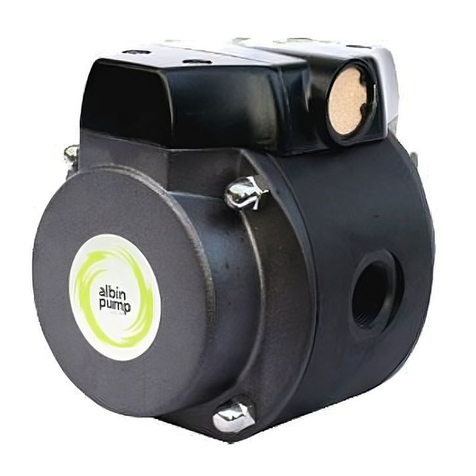
PRODUCT SAFETY INFORMATION – WHEN PLACING THE PUMP IN SERVICE
WARNING
•Ensure electrical installation is performed by a qualied electrician.
•Lockout and tag out the main electrical supply to prevent possibility of power being supplied to the pump during installation or
maintenance.
•The owner / electrical contractor must size the feeder cables to ensure that the circuit is balanced and not overloaded by other
electrical equipment.
•Connect the pump only to electrical systems that are compatible with its electrical characteristics and that are within its rated ca-
pacity. Do not connect to an electrical supply of incorrect voltage and/or frequency.
•Install a main line disconnect switch on the incoming line. The pump is not equipped with an electrical disconnecting device. The
owner is responsible for the design and installation of disconnect, over voltage, short circuit, and overload protection.
•For any operation / maintenance of the pump, it is necessary to make certain that the pump is stopped and the electrical supply
disconnected.
•The start system of the motor should be provided with a direction inverter, stop-go button and emergency stop button (together with
the pump), in such a way that the pump can be operated with total safety.
•Always make sure the voltage on the pump data plate matches the installation voltage before plugging the pump into a wall outlet or
connecting to an electrical supply. If you are unsure, have a licensed electrician inspect and install your pump.
•To reduce the risk of electrical shock-before maintenance, repair, or moving, always disconnect the power to the pump.
•Provide suitable grounds, clearance and lightning arrestors for all electrical components.
•Verify grounding connections after initial installation and periodically thereafter to ensure good contact and continuity has been
maintained.
Handling
CAUTION
Follow these instructions while lifting the pump :
•Lift the complete pump using the lifting holes / rings plus additional support on the gearbox and the motor using
•suitably rated straps or slings.
•Always use lifting equipment of proper capacity. Never exceed the upper limits of the lifting equipment.
•The pump will tend to tilt towards the pump casing side due to its center of gravity. Make sure that personnel are at a safe distance
from the pump to avoid any risk of injury while it is being lifted.
•Never lift the pump by its suction / discharge connections
Installation
•Verify correct pump model and con guration prior to installation.
•Install the pump in a well-ventilated area away from heat sources. Provide enough space behind the motor ventilator hood so as not
to obstruct air intake.
•The position of the pump should allow easy access to all maintenance operations.
•Pumps are tested in water during assembly. Flush pump with compatible uid prior to installation.
•Protect the pump from external damage and do not use the pump for structural support of the piping system. Be certain that the
system components are properly supported to prevent stress on the pump parts.
PRODUCT SAFETY INFORMATION – WHEN USING THE PUMP
WARNING
•Maximum surface temperature depends on the operating conditions of the motor, pump and hose friction. Do not exceed maximum
temperature limits. Refer to the Instruction Manual for maximum temperature limits.
•High Pressure can cause personal injury, death, pump damage or property damage.
•Be sure that connecting hoses and other piping components are able to withstand uid pressures developed by this pump.
•Do not exceed the maximum material pressure of any component in the system.
•Do not service or clean pump and hoses while the pump is running.
•During hose replacement, the hose can come out of the pump casing very fast and cause harm. No personnel must be in front of
the pump’s suction / discharge side while replacing the hose.
•Pump damage caused by improper mounting, piping stress and external damage can result in uid leakage. Insucient lubricant
levels in the pump can generate surface temperatures higher than the recommended temperature limit of the pump. Refer to the
Instruction Manual for lubrication requirements.
•Be certain all operators of the pump have been trained for safe working practices, understand its limitations, and wear appropriate
eye, hearing and other personal protection as required.
EN


























